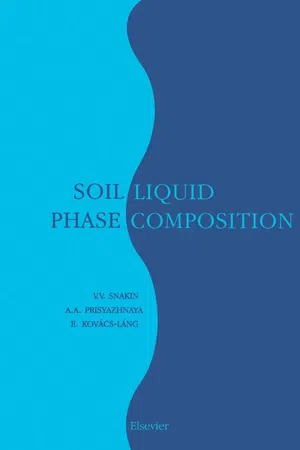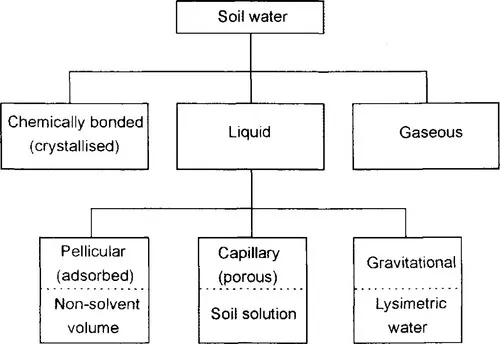
Soil Liquid Phase Composition
V.V. Snakin,A.A. Prisyazhnaya,E. Kovács-Láng
- 319 pages
- English
- ePUB (mobile friendly)
- Available on iOS & Android
Soil Liquid Phase Composition
V.V. Snakin,A.A. Prisyazhnaya,E. Kovács-Láng
About This Book
The liquid phase of soil (soil solution) is a very thin, penetrating and all-embracing water layer. It has the most extensive surface among the biosphere components and interacts with all these components. Presented in this work is a new complex approach developed for soil liquid phase investigation that is based on in situ measurements. Investigation of the soil liquid phase can be of great significance in environmental research.
This volume sums up the vast experience of the authors' research into soil liquid phase composition in various ecosystems of Central and Eastern Europe. It describes the methodological basics of soil liquid phase research: methods of soil solution extraction, the main problems of application of ion-selective electrodes for immediate in situ assessment of ionic activity in soil liquid phase and redox potential, and ways to overcome those problems. Data are presented on soil liquid phase composition in natural and agricultural ecosystems, their redox, pH, carbonate and other regimes as well as the relations between the composition of the soil liquid phase and different ecological properties.
This work is devoted to the pursuit of new approaches to soil liquid phase analysis with a goal of discovering the role of soil liquid phase in the functioning of natural and agricultural ecosystems in recent soil-formation, formation of primary biological production, and in bio-geochemical turnover of elements. It includes new field investigation data as well as all data generalization carried out by means of a special complex database (developed by the authors) on soil liquid phase composition and other soil-ecological properties in various ecosystems in Central and Eastern Europe.
This book is the first English edition that integrally considers both methodological aspects and results of investigation of composition, formation, dynamics, spatial heterogeneity, and interrelations of soil liquid phase with other components of ecosystems. Soil scientists, agricultural chemists and ecologists will find this title of great interest.
Frequently asked questions
Information
Soil Liquid Phase as a Structural Element of an Ecosystem
1.1 TYPES OF SOIL WATER

1.1.1 PELLICULAR WATER

Table of contents
- Cover image
- Title page
- Table of Contents
- Copyright page
- Introduction
- Acknowledgments
- Chapter 1: Soil Liquid Phase as a Structural Element of an Ecosystem
- Chapter 2: Soil Liquid Phase Investigation
- Chapter 3: Study Areas
- Chapter 4: Environmental Impact on the Soil Liquid Phase
- Chapter 5: Spatial and Temporal Properties of Soil Liquid Phase
- Chapter 6: Material and Energy Exchange in Ecosystems
- Chapter 7: Environmental Processes and Soil Liquid Phase
- Summary
- Glossary
- References
- Correlation Between Soil Names*
- Subject Index
- Author Index